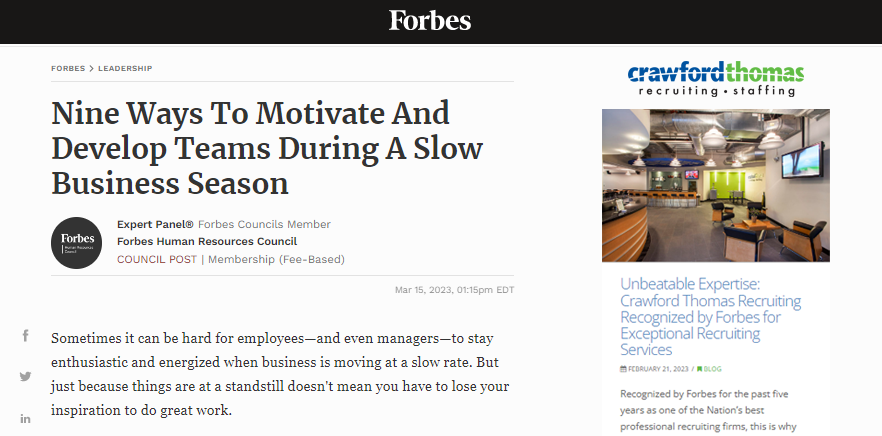
Expert Panel® Forbes Councils Member Forbes Human Resources Council
Original Article here.
Sometimes it can be hard for employees—and even managers—to stay enthusiastic and energized when business is moving at a slow rate. But just because things are at a standstill doesn’t mean you have to lose your inspiration to do great work.
Whether it’s providing your team with the additional opportunity to learn and grow in the work environment, planning a community service project for the entire team to engage in or taking some well-deserved PTO before your busy quarters begin again, there are plenty of ways to fill in the gaps and continue to stay productive so you can brainstorm new ideas to further the company mission. Here are nine best practices that Forbes Human Resources Council members have implemented to boost employee morale on the job and keep the business moving forward even with a sluggish economy.

1. Create Focus Groups To Spark Innovative Initiatives
Provide employees with opportunities to create focus groups for innovative initiatives. Encourage them to challenge the norms by cross-functionally engaging to brainstorm in a “what if” design. Acknowledge those groups who submit ideas that have never been attempted before and allow them to present their ideas directly to senior leadership members who they may not have exposure to otherwise. The key is that innovation plus connection equals growth. – Amanda Connelly, CMP
2. Use The Free Time To Train And Develop Employees
Leverage the time to upskill people through job shadowing, “lunch and learns” and mentoring. Given the decreasing shelf life of skills, people need to be in a continuous learning mindset. Therefore, learning when there is a pause in the business allows time for the behavioral shift, leadership support, reinforcement and practice in the workflow. – Maria Leggett, AvidXchange
3. Develop Performance-Based Pay Incentives
To help employees stay positive and focused during the winter months or slow seasons, employers should consider tying pay to performance. Revamping rewards programs to include performance-based pay gives employees the motivation needed to stay on task and incentivizes them to reach new professional goals without employers needing to increase their budget. Offering more reward options can boost morale and lead to company-wide success. – Tanya Jansen, beqom
4. Plan Fun Team Activities
Plan joyful, engaging team activities outside of work to reenergize the times. For example, engaging in a fun “Kahoot” game, a “Goosechase” challenge or a bake-off are just a few activities that are always fun, and you can also give away prizes. – Britton Bloch, Navy Federal
5. Encourage Your Team To Take A Day Off
Encourage your team to use PTO during slow periods. Planning a training session or infrastructure upgrades are also great ways to invest in the future of the business. For example, during Covid—when business was slow—our company used some of that time to implement an incredible business intelligence plan. This enabled our team to go places we didn’t think were possible once the economy roared back to life. – William Stonehouse, Crawford Thomas Recruiting
6. Ask Employees How Leadership Can Help
Ask your employees what they enjoy the most about their jobs, what their biggest challenges are and what they need help with. It’s important to ask them these questions because every person and organization can differ. I recommend using a survey method because it gives you data that you can leverage to get buy-in from others. It can also help you form a required budget to take action on some of the initiatives or ideas that the employees have shared. – Sanja Licina, QuestionPro
7. Get The Team Involved In Community Outreach
Host fun, culture-creating and philanthropic activities both in person and remotely. Some examples can be terrarium-making for team building and reading to children virtually as well as creating care packages to give back to those in need. It is great to schedule these types of activities every quarter intentionally—even when it is not winter and business is not slow. – Gianna Driver, Exabeam
8. Create Social Committees Or Side Projects
People want to contribute and drive their own outcomes, so help them do that! On the social side, create social committees, give them a budget and let them decide what kinds of engagement activities they’d like to do for their group or location. On the business side, create side projects to allow people to develop their skills while solving real business problems. – Tracy Cote, StockX
9. Connect With Your Team On Purpose
Find ways to be intentional about connecting with your staff members. Whether it’s through planned one-on-one conversations or accidental meetings at the water cooler, leaders must find ways to be plugged in. These conversations are where challenging assignments and experiences are extended, mentorship relationships are entered into and requests, personal and professional, are made. – Domonique Revere, Adjaye Associates

Successful HR executives from Forbes Human Resources Council offer leadership and management insights.
Crawford Thomas Recruiting:

Crawford Thomas is a team of leading HR recruiters. We not only fill staffing needs, we partner with organizations to find out how their recruiting needs tie into their business objectives. Through this, we are able to meet your staffing needs in a way that achieves organizational success.
Start securing top talent by visiting our page for employers today.

